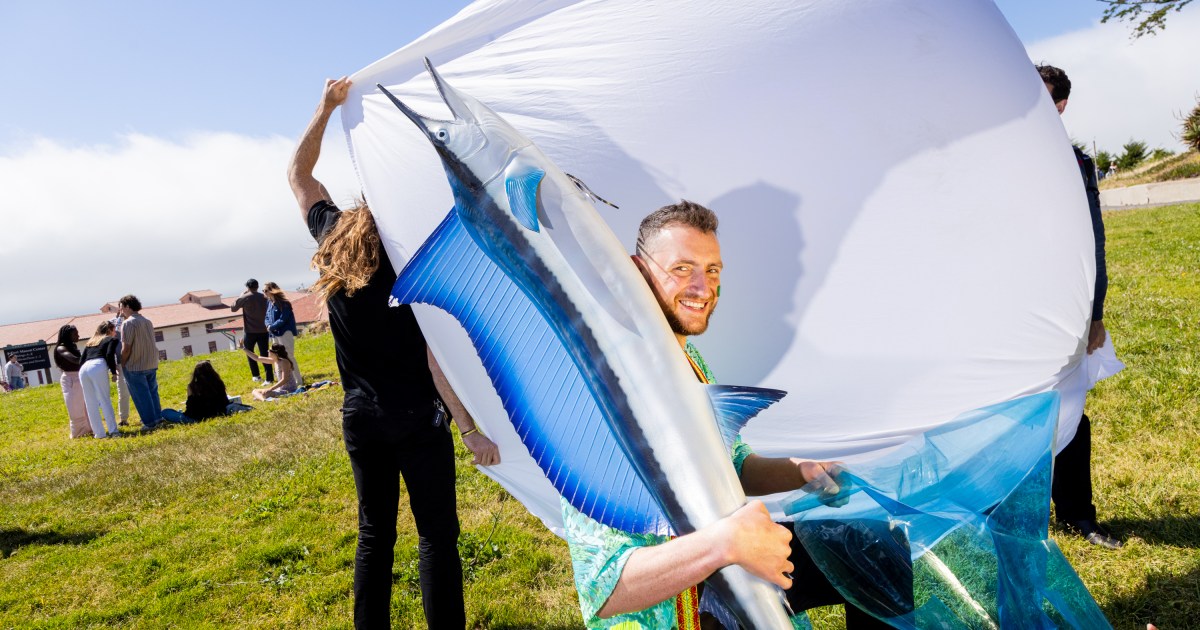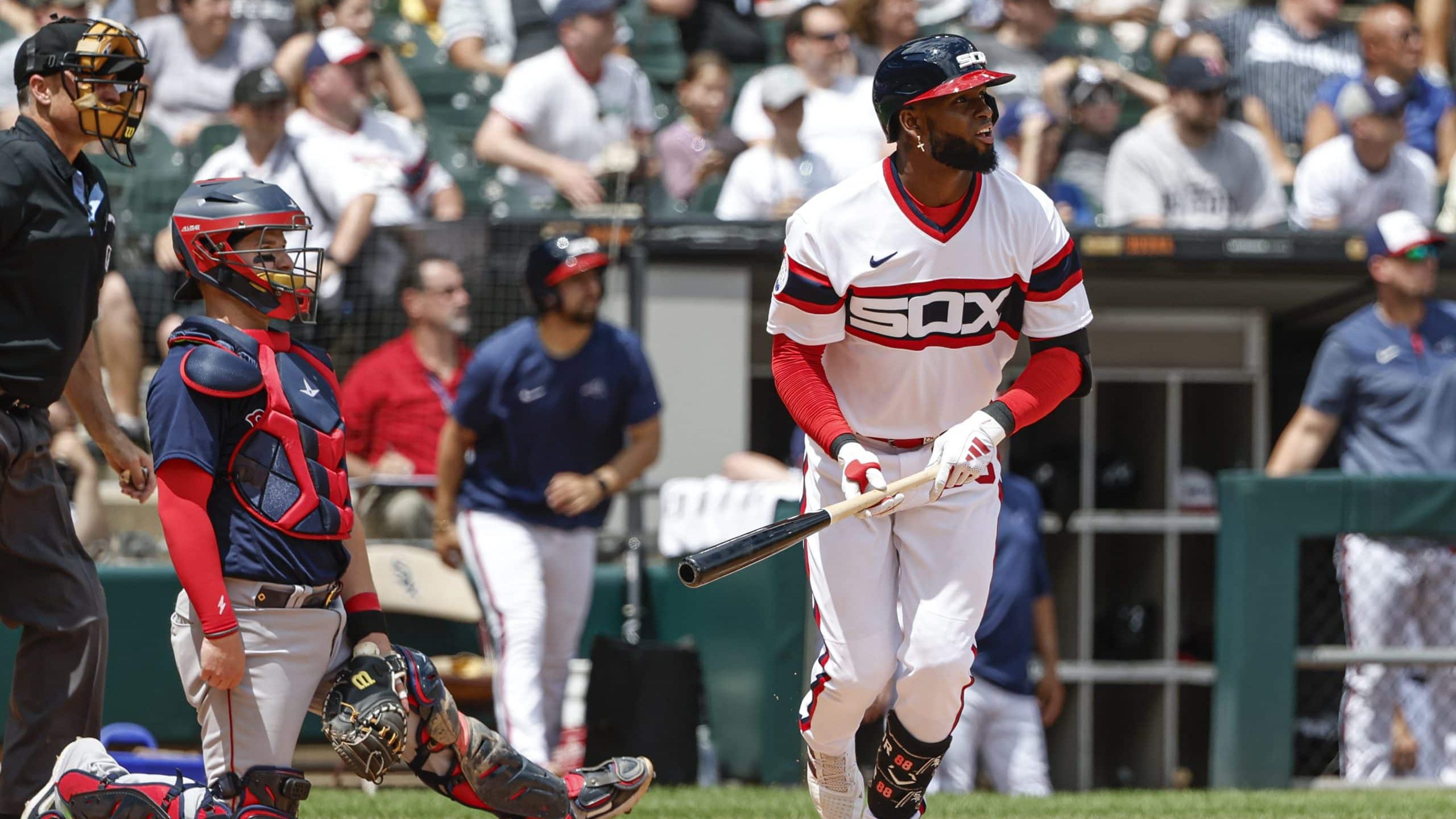World
From Marseille to Mont-Blanc: What to know about the journey of the Olympic torch to Paris
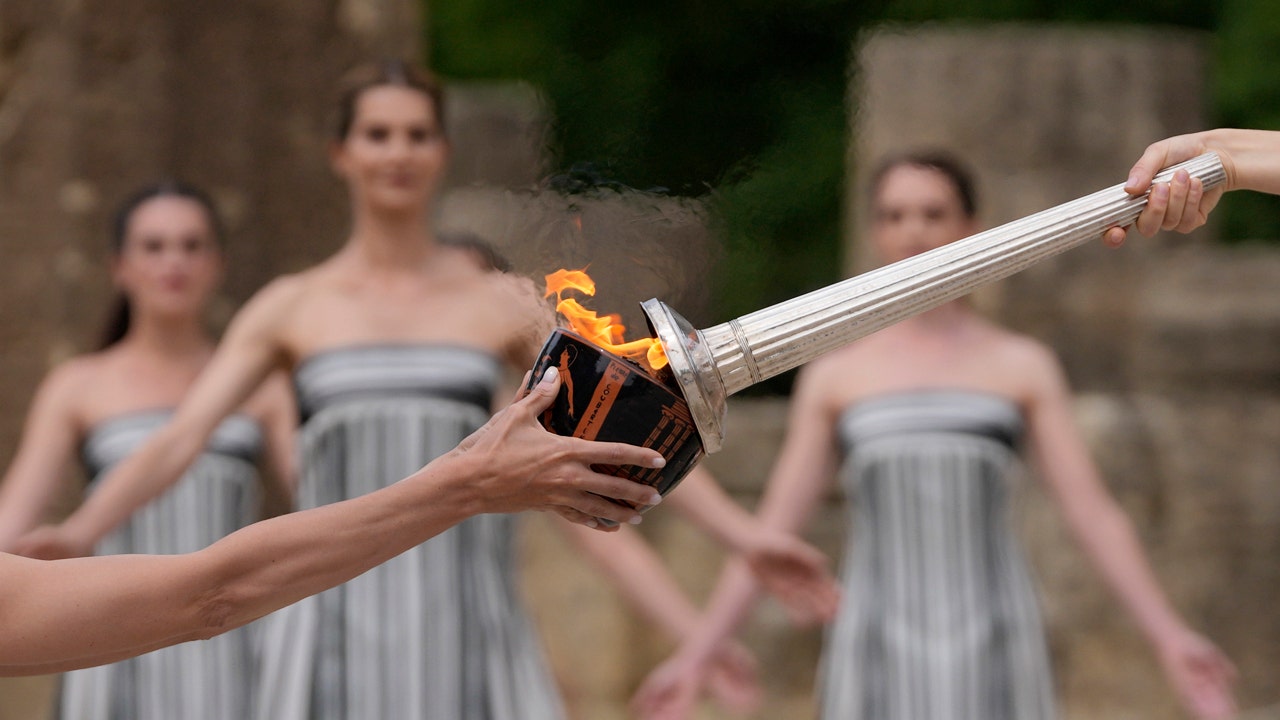
The Olympic torch will finally enter France when it reaches the southern seaport of Marseille on Wednesday. And it’s already been quite a journey.
After being lit on April 16 in Ancient Olympia, the torch was carried around Greece before leaving Athens aboard a three-mast ship named Belem, headed for Marseille.
OLYMPIC TORCH-LIGHTING CEREMONY EXPLAINED: WHAT TO KNOW AHEAD OF THE PARIS GAMES
The Belem was first used in 1896, the same year the modern Olympics came back. It will be accompanied by more than 1,000 boats as it parades around the Bay of Marseille, before arriving at the Vieux-Port, or Old Port, and docking on a pontoon resembling an athletics tracks.
Torch bearers will carry the flame across Marseille the next day, the last stretch running on the roof of the famed Stade Vélodrome, home to Marseille’s passionate soccer fans.
After leaving Marseille, a vast relay route will be undertaken before the torch’s odyssey ends with the opening ceremony of the Games on July 26 in Paris.
Here’s a look at where the torch goes before reaching Paris:
MONT-SAINT-MICHEL
The torch is due to reach the famed and visually stunning site of Mont Saint-Michel in Normandy on May 31.
Located in an area of raised land surrounded by water, the island fortress looks like it was created for a Game of Thrones film set. But it’s real, and very old.
Actress Mary Mina, playing high priestess, right, lights a torch during the official ceremony of the flame lighting for the Paris Olympics, at the Ancient Olympia site, Greece, April 16, 2024. The Olympic torch finally enters France when it reaches the southern seaport of Marseille on Wednesday, May 8, 2024, on an armada from Greece. After leaving Marseille, a vast relay route will be undertaken before the torch’s odyssey ends on July 27 in Paris. (AP Photo/Thanassis Stavrakis)
So old that it already existed during the Hundred Years’ War between England and France, from 1337 to 1453. An English attack was even fended off. Later it became a prison, and in 1979 it was named a UNESCO World Heritage Site.
Every years swarms of tourists are in awe of its raw and haunting beauty.
ACROSS THE OCEANS
The torch travel route is even more unique considering it takes a detour through France’s overseas territories called the Relais des Océans, or Ocean Relay. Riding the waves of the Atlantic, Pacific and Indian Ocean, it will be in French Guiana on June 9 before hitting New Caledonia on June 11.
Next is the island of Réunion at Saint-Denis — coincidentally the same name as the Paris suburb with the Olympic village — before reaching Papeete in the surfing realm of Tahiti, then Baie-Mahault in Gaudeloupe and finally Fort-de-France in Martinique.
The torch comes back to France on June 18 in the southern city of Nice.
FROM SEA BREEZE TO HEAVY CHEESE
Just five days after landing on French shores, the torch heads up the Alpine mountain pass of Chamonix-Mont-Blanc for Olympic Day on June 23.
The Haute-Savoie region is known for its outstanding Chamonix ski resort, which hosts World Cup races, for sweeping views across glacier fields to nearby Italy, and — some would say more importantly — as a producer of fine cheese.
A Cheese Olympics, should it be invented, would feature a sturdy crew of eight competitors from Savoie: Abondance, Beaufort, Chevrotin, Emmental, Reblochon, Tome, Tomme and the heavy-duty Raclette.
HEADING FOR PARIS
After leaving fromage-friendly Savoie, torch bearers will digest in the Doubs region of eastern France, and then visit the Alsace city of Strasbourg in the northeast.
Three days later the torch will reach Verdun, the site of one of the most horrific battles of World War I. From February to December 1916, more than 700,000 French and German soldiers were killed or wounded at the Battle of Verdun.
BASTILLE DAY ARRIVAL
The torch is to arrive on the streets of Paris on July 14 — hardly surprising, considering it’s Bastille Day, France’s national day.
The torch will stay the following day in Paris, then exit again before snaking back to the French capital via Versailles — home to the resplendent Royal Palace — and the suburbs of Nanterre on July 24 and Seine Saint-Denis on July 25.
From there, it’s to travel a very short distance back to Paris on July 26 for the grandiose opening ceremony where athletes will parade on more than 80 boats at sunset on the Seine River.
FINAL DESTINATION?
After the nearly four-hour ceremony ends shortly after 11 p.m., the cauldron will be lit at a location that is being kept top-secret until the day itself. Among reported options are such iconic spots as the Eiffel Tower and the Tuileries Gardens outside the Louvre Museum.
FLAME PROTECTION
A total of 10,000 people will carry the torch along its route. Local police forces on each section of the relay will help to ensure security is high, providing a security bubble around the torch and its carrier.
ECO-FRIENDLY
The torches have a lower environmental impact than those used at previous Games. They burn biogas instead of propane and are recharged when fuel runs out.
Around 2,000 torches will be used compared to more than 10,000 before, according to Georgina Grenon, the director of environmental excellence at Paris 2024. The torches are made with recycled steel and not new aluminum.

World
Ukraine and Russia exchange drone attacks while Russia continues its push in the east
KYIV, Ukraine (AP) — Russia said it shot down some 60 drones and several missiles over its territory while Ukraine in turn said it destroyed over 30 Russian drones. At least four people were reported killed in an attack on the outskirts of Kharkiv on Sunday as Russia pushed ahead with its renewed offensive in Ukraine’s war-ravaged northeast.
Russian air defenses shot down 57 Ukrainian drones over the southern Krasnodar region overnight, the Russian Defense Ministry said.
Local military officials said drone debris hit an oil refinery in the town of Slavyansk-on-Kuban, but there was no fire or damage. News outlet Astra published videos appearing to show an explosion at the refinery as it was hit by a drone. The videos could not be independently verified.
Nine long-range ballistic missiles and a drone were destroyed over the Russia-occupied Crimean Peninsula, following Friday morning’s massive Ukrainian drone attack that cut off power in the city of Sevastopol.
A further three drones were shot down over the Belgorod region, which borders Ukraine. According to regional Gov. Vyacheslav Gladkov, a church roof was set on fire by falling drone debris, but there were no casualties.
The Russian-installed governor of Ukraine’s partially occupied Kherson region, Vladimir Saldo, said that one person died and 16 were wounded when a Ukrainian drone hit a minibus on Sunday morning.
In Ukraine, air force officials said air defenses shot down all 37 Russian drones launched against the country overnight.
In the northeastern Kharkiv region, where Moscow recently launched a new offensive, regional Gov. Oleh Syniehubov said Sunday morning that one person died and 11 were wounded as a result of shelling over the previous day.
Later on Sunday, Syniehubov said four people were killed and eight wounded in a Russian strike on the outskirts of the regional capital, also called Kharkiv.
Ukrainian troops are fighting to halt Russian advances in the Kharkiv region that began late last week.
Russian President Vladimir Putin said on Friday during a visit to China that Moscow’s offensive in the Kharkiv region aims to create a buffer zone but that there are no plans to capture the city.
——
Morton reported from London.
——
Follow AP’s coverage at https://apnews.com/hub/russia-ukraine
World
Argentina's Milei shuts up critics with miracle turnaround of economy, strong security policies

President Javier Milei of Argentina continues to stun his critics with an economy that has outperformed expectations and continues along an ambitious path for national security, including pursuit of a NATO global partnership.
“The fact that you have a president, head of state, who is defending the free market, who is defending the role of entrepreneurs and businessmen as creators of value and just defending deregulation when the tendency in Latin America and much of the West has been to regulate the economy . . . I think that’s very positive, not only for Argentina, but for the region as a whole and maybe beyond,” Daniel Raisbeck, a policy analyst at the CATO Institute, told Fox News Digital.
Milei won the presidency in November last year and prompted concern from some in the West that he would lead his country down a road to ruin with libertarian policies that would make an already troubled economy even weaker. Voters wanted economic relief from a market hit with some of the highest inflation in the world.
Those attitudes have shifted just months later as Milei has enacted a raft of policy changes: The International Monetary Fund (IMF) agreed to release a tranche of loans due to Argentina under a bailout program thanks to Milei’s government managing to create a fiscal surplus in the previous fiscal quarter and bring inflation down.
ARGENTINA REPORTS ITS FIRST SINGLE-DIGIT INFLATION IN SIX MONTHS AS MARKETS SWOON AND COSTS HIT HOME
President of Argentina Javier Milei gives a speech after his Inauguration Ceremony at National Congress on December 10, 2023, in Buenos Aires, Argentina. (Marcelo Endelli/Getty Images)
Argentina’s inflation in March alone hit 287%, causing poverty to deepen, and citizens to take to the streets with strikes and protests against his policies. The monthly inflation rate was 25% in December when Milei first took office.
Milei then went on to significantly reduce spending with major cuts to public-sector wages as he suspended public works projects and cut subsidies. He also devalued the country’s currency by over 50%, which helped it stabilize in value even as the price of basic goods jumped.
The monthly inflation dropped to 8.8% by April, marking the first single-digit inflation rate in over six months.
Argentina recorded a $589 million budget surplus in January and continued to post a surplus for each of the first four months of 2024, even as the surplus shrank to $299 million in April, Reuters reported. This marks the country’s first quarterly surplus since 2008.
Raisbeck stressed that Milei’s primary measure of cutting spending has proven highly effective, while arguing that the significant deregulation in other parts of the economy has helped it revive over those first months of the new administration.
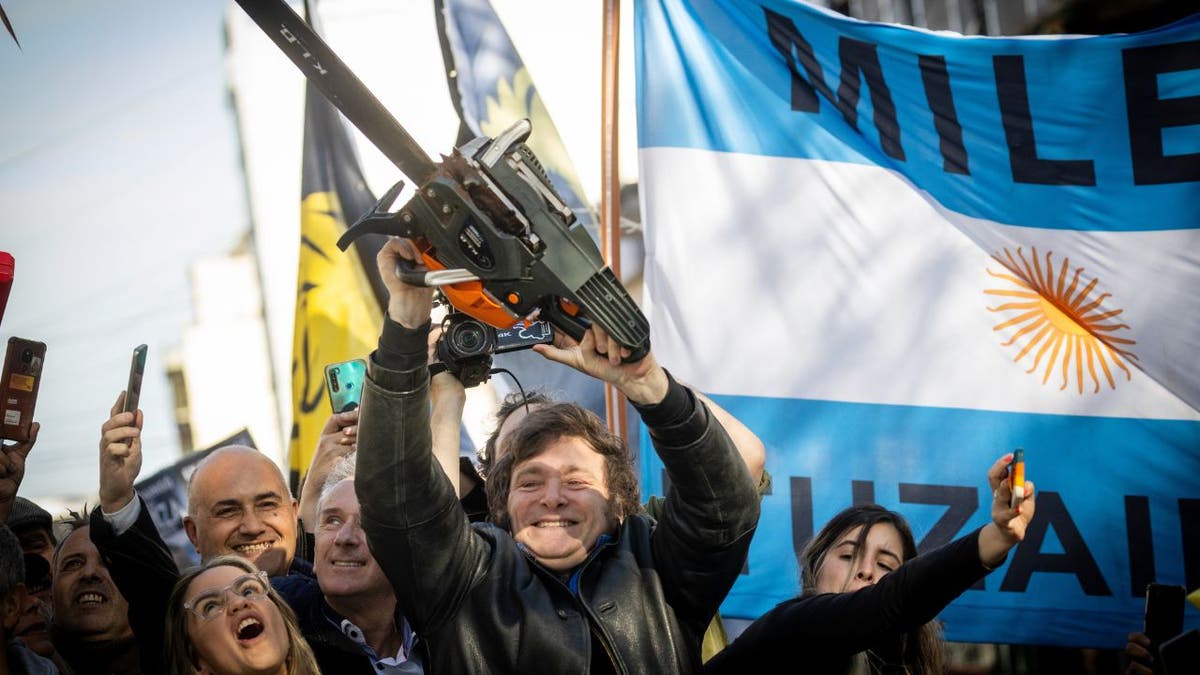
Javier Milei of La Libertad Avanza lifts a chainsaw next to Buenos Aires province governor candidate Carolina Piparo of La Libertad Avanza during a rally on September 25, 2023, in San Martin, Buenos Aires, Argentina. (Tomas Cuesta/Getty Images)
“Argentina was one of the most regulated economies in the world,” Raisbeck said. “So when you have a very well-thought-out package like the one that they introduced . . . and you get rid of as many of those regulations as you can, then it’s very positive.”
AT LEAST 90 INJURED AFTER PASSENGER TRAIN HITS BOXCAR, DERAILS IN ARGTENTINE CAPITAL
He noted that Milei has not adhered to some of his more aggressive campaign promises, which included a promise to dollarize the economy and shut down the Central Bank, saying that it was a “non-negotiable matter.”
Even days after he won the election, Milei appeared to favor more moderate Cabinet members than many would have expected of a man who jolted the international community with his outsider attitude and plans.
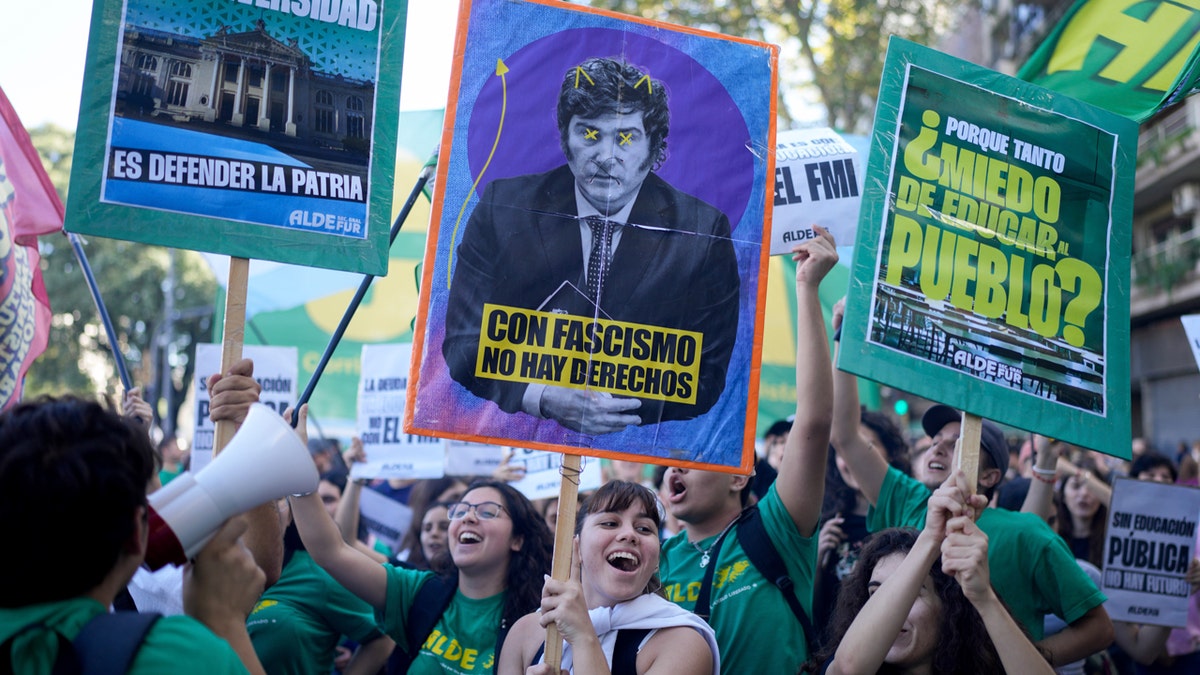
Students protest for more public university funding and against austerity measures proposed by President Javier Milei, featured on the sign, in Buenos Aires, Argentina, Tuesday, April 23, 2024. The posters read in Spanish, “With fascism, there are no rights,” center, and “Why so much fear to educate the people?” and “Defending the university is defending the country.” (AP Photo/Natacha Pisarenko)
The Wall Street Journal, in December 2023, argued that Milei’s tenure “may turn out to be pretty conventional,” with pro-market Economy Minister Luis Caputo leading away from Milei’s more radical plans.
The promised dollarization has been delayed, and Raisbeck explained that Milei’s approach has relied heavily on using the Central Bank to help regulate the economy, though he argued that Milei’s policies remain libertarian due to the deregulation he has pursued in other areas.
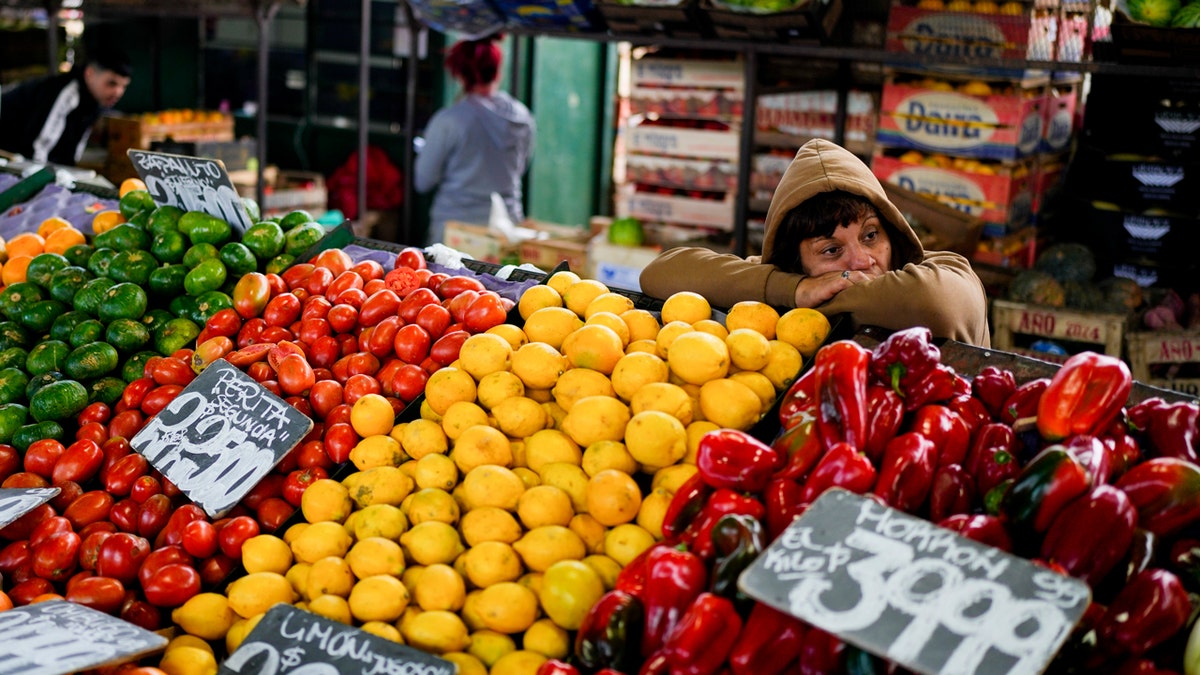
A vendor waits for customers at the central market for fruit and vegetables in Buenos Aires, Argentina, Friday, May 10, 2024. (AP Photo/Natacha Pisarenko)
“Everything related to deregulation is very libertarian, and we’ve seen great success already in the housing market, for instance,” Raisbeck said. “So that obviously brought a huge amount of supply that was suppressed because of price controls.”
Milei also brought Argentina back to the international foreground, with a stronger focus on national security and changing up the country’s goals from the previous administration – most notably, he rejected the invitation to join the China and Russia-led economic bloc BRICS.
PERUVIAN LAWMAKERS BEGIN YET ANOTHER EFFORT TO REMOVE PRESIDENT DINA BULARTE FROM OFFICE
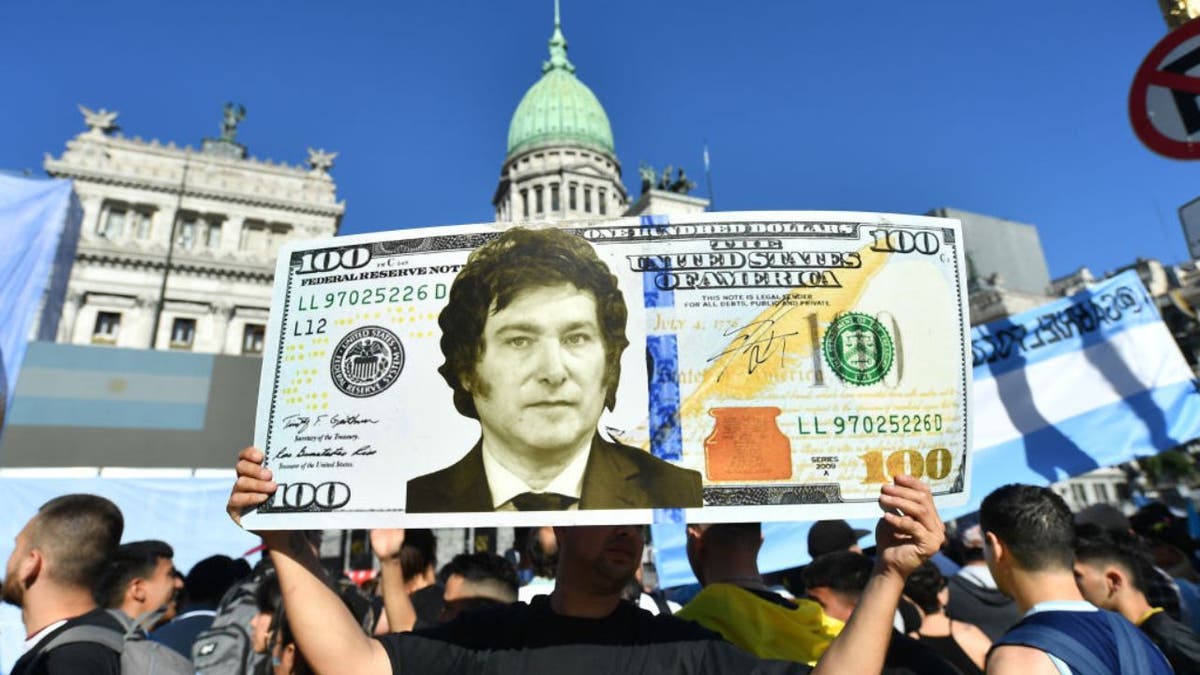
A supporter holds a giant dollar bill with the face President elect Javier Milei as people start gathering outside National Congress ahead of his inauguration ceremony on December 10, 2023, in Buenos Aires, Argentina. (Marcelo Endelli/Getty Images)
Milei argued that it was not “opportune” for Argentina to join the bloc as a full member, according to German outlet DW. However, he will continue to develop ties with its members in the meantime.
“They have a good security minister, Patricia Bullrich, who has experience because she was a security minister in the previous government,” Joseph M. Humire, the executive director of the Center for a Secure Free Society, told Fox News Digital. “She has been able to get the ball rolling very quickly, and I think that was the benefit of having her in that position.”
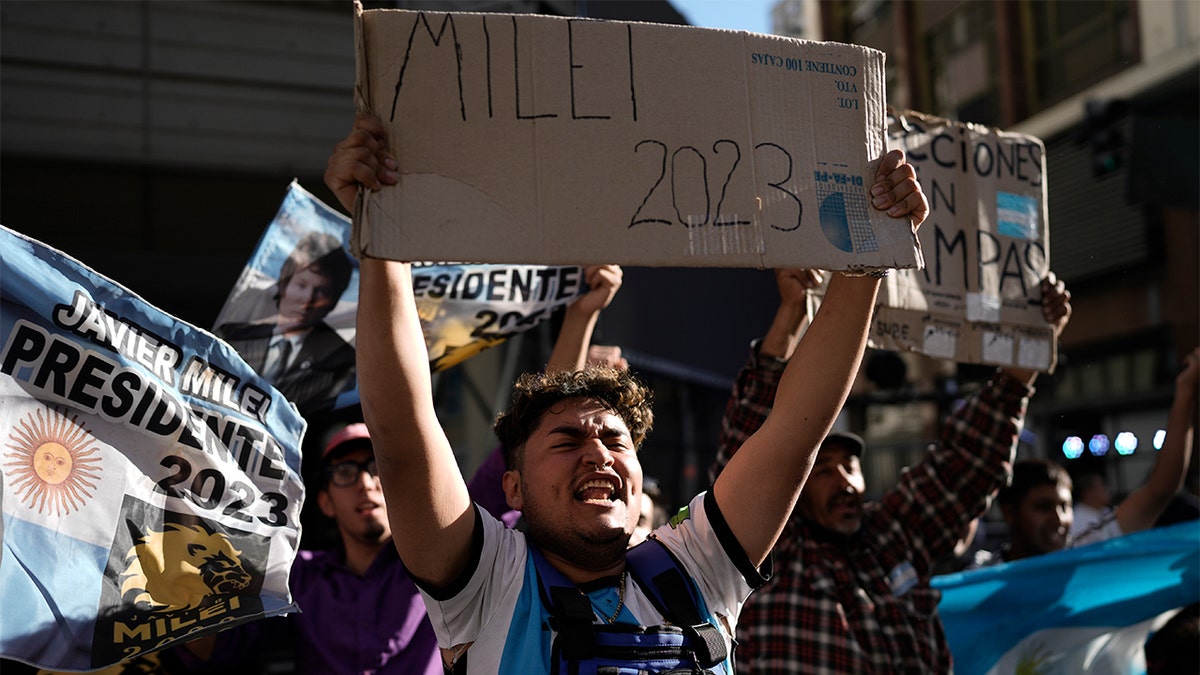
Supporters of presidential candidate Javier Milei gather outside his headquarters during the presidential runoff election in Buenos Aires, Argentina, Sunday, November 19, 2023. (AP Photo/Rodrigo Abd)
Humire explained that Milei’s government has largely focused on clearing out external agitators, particularly those connected to Russian disinformation networks, which remain a paramount concern in most parts of the world as Moscow seeks to expand its influence.
“The external forces are usually the key,” Humire said. “Usually, it’s the Russians. The Russians have probably the biggest disinformation networks to be able to amplify local grievances and turn them into this macro instability, and they did that in Colombia, in Chile.”
“A lot of the specifics of the nation’s security has been in mitigating these agitation networks that create chaos throughout the country, and they have been neutralizing some of these threats while they’re studying others,” he added.
The Associated Press contributed to this report.
World
Russia-Ukraine war: List of key events, day 815

Here is the situation on Sunday, May 19, 2024.
Fighting
- Slavyansk oil refinery in Russia’s southern Krasnodar region halted operations following a Ukrainian drone attack overnight, Interfax news agency reported. The refinery is a private plant with a capacity of 4 million metric tonnes of oil per year, about one million barrels per day.
-
Ukraine’s air force claimed it destroyed all 37 Shahed attack drones launched by Russia overnight. The regions targeted by the drones include Kyiv, Odesa, Mykolaiv, Sumy, Vinnytsia, Zhytomyr, Cherkasy and Kherson.
- The governor of Kharkiv said nearly 10,000 people had been forced to leave their homes since Russian forces launched a surprise ground attack on May 10. Russia claimed its military took control of another village, Staritsya, in the Kharkiv region near the Russian border.
- Ukrainian prosecutors said Russian shelling killed a 60-year-old woman and injured three other civilians in the northeast city of Vovchansk, 5km (3 miles) from the Russian border. A 59-year-old man was also injured in the village of Ukrainske.
- Russia said its forces shot down nine US ATACMS missiles over Crimea and at least 60 drones over Russian sovereign territory. Its forces also shot down a Tochka-U missile fired by Ukraine in Russia’s Belgorod region.
- Belgorod regional Governor Vyacheslav Gladkov said a Ukrainian drone attack injured a woman and a man in the village of Petrovka. The two were treated for shrapnel injuries.
Politics and diplomacy
- Ukrainian President Volodymyr Zelenskyy acknowledged issues with staffing and “morale” within the country’s troops as he signed a mobilisation law that came into force on Saturday. Kyiv has lowered the age at which men can be drafted from 27 to 25 and tightened punishments for those who avoid the call-up.
- Ukrainian prosecutors said they were investigating as a potential war crime a Russian air attack on a residential area of the regional capital, Kharkiv, in which six civilians were wounded, including a 13-year-old girl, 16-year-old male and an eight-year-old.
- Ukrainian officials accuse Russian soldiers in Vovchansk of using dozens of captured civilians as “human shields” to defend their command headquarters.
- Moscow denied deliberately targeting civilians even as thousands have been killed and injured since its February 2022 invasion of Ukraine.
- Poland announced it would spend $2.5bn to fortify its eastern border, which includes Russia, Belarus and Ukraine.
-

 Finance1 week ago
Finance1 week agoSpring Finance Forum 2024: CRE Financiers Eye Signs of Recovery
-

 World1 week ago
World1 week agoIndia Lok Sabha election 2024 Phase 4: Who votes and what’s at stake?
-

 Politics1 week ago
Politics1 week agoBiden’s decision to pull Israel weapons shipment kept quiet until after Holocaust remembrance address: report
-

 News1 week ago
News1 week agoThe Major Supreme Court Cases of 2024
-

 Politics1 week ago
Politics1 week agoTales from the trail: The blue states Trump eyes to turn red in November
-

 World1 week ago
World1 week agoBorrell: Spain, Ireland and others could recognise Palestine on 21 May
-

 Politics1 week ago
Politics1 week agoFox News Politics: No calm after the Stormy
-

 World1 week ago
World1 week agoUkraine’s Zelenskyy fires head of state guard over assassination plot


